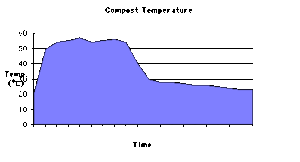Compost pile: Difference between revisions
| Line 37: | Line 37: | ||
==References== | ==References== | ||
[ | [1]Michaelides, Adam. Compost Education Program . 31 Dec 2007. 21 Aug 2008 <http://counties.cce.cornell.edu/tompkins/compost/Basics%20&%20Bennefits%20of%20Composting.pdf>. | ||
[2]Olynciw, Nancy Trautmann and Elaina. Compost Microorganisms. 1995. 21 Aug 2008 <http://compost.css.cornell.edu/microorg.html>. | |||
Edited by [Natasha Naidu], students of [mailto:ralarsen@ucsd.edu Rachel Larsen] | Edited by [Natasha Naidu], students of [mailto:ralarsen@ucsd.edu Rachel Larsen] | ||
Revision as of 02:15, 29 August 2008
Introduction
Compost is decomposition of Organic Matter such as kitchen scraps, wood shavings, yard trimmings, paper and cardboard. Compost supplies nutrients and advantageous life to the soil, develops better soil structure, and helps prevent overflow that can contaminate water streams such as rivers and lakes. Compost helps the soil soak up and preserve nutrients and provides plants protection from pests and diseases. Moreover, compost provides moisture which means less watering where you can conserve water and prevent river or lake pollution. Compost introduces and feeds diverse life in the soil, including bacteria, insects, worms, and more, which support vigorous, plant growth. Compost pile also helps yard protection during rainstorm. An excess of nutrients in water can deplete the oxygen available to fish and other aquatic life.1
Figure shows As you can see bacteria, fungi, and other microbes, these organisms make up a complex food web or energy pyramid with primary, secondary, and tertiary level consumers. The base of the pyramid, or energy source, is made up of organic matter including plant and animal residues. Organic residues such leaves or other plant materials are eaten by some types of invertebrates such as millipedes, sow bugs, snails and slugs. These invertebrates shred the plant materials, creating more surface area for action by fungi, bacteria, and actinomycetes (a group of organisms intermediate between bacteria and true fungi), which are in turn eaten by organisms such as mites and springtails.2
Description of Niche
Compost Temperature
In the process of composting, microorganisms shatter down organic matter by producing carbon dioxide, water, heat, and humus. Under optimal conditions, composting proceeds through three phases: 1) the mesophilic, or moderate-temperature phase, which lasts for a couple of days, 2) the thermophilic, or high-temperature phase, which can last from a few days to several months, and finally, 3) a several-month cooling and maturation phase.
Figure 2 Different communities of microorganisms predominate during the various composting phases. Starting decomposition carried by mesophilic microorganisms, which rapidly break down the soluble, readily degradable compounds. Temperature rises above 40°C, the mesophilic microorganisms become less competitive and are replaced by others that are thermophilic, or heat-loving. At temperatures of 55°C and above, many microorganisms that are human or plant pathogens are destroyed. High temperatures accelerate the breakdown of proteins, fats, and complex carbohydrates like cellulose and hemicelluloses, the major structural molecules in plants. Over 65°C kill many forms of microbes and limit the rate of decomposition, compost managers use aeration and mixing to keep the temperature below this point. Final phase of "curing" or maturation of the remaining organic matter.2
Who lives there?
Which microbes are present?
You may refer to organisms by genus or by genus and species, depending upon how detailed the your information might be. If there is already a microbewiki page describing that organism, make a link to it.
Do the microbes that are present interact with each other?
Describe any negative (competition) or positive (symbiosis) behavior
Do the microbes change their environment?
Do they alter pH, attach to surfaces, secrete anything, etc. etc.
Do the microbes carry out any metabolism that affects their environment?
Do they ferment sugars to produce acid, break down large molecules, fix nitrogen, etc. etc.
Current Research
Enter summaries of the most recent research. You may find it more appropriate to include this as a subsection under several of your other sections rather than separately here at the end. You should include at least FOUR topics of research and summarize each in terms of the question being asked, the results so far, and the topics for future study. (more will be expected from larger groups than from smaller groups)
References
[1]Michaelides, Adam. Compost Education Program . 31 Dec 2007. 21 Aug 2008 <http://counties.cce.cornell.edu/tompkins/compost/Basics%20&%20Bennefits%20of%20Composting.pdf>. [2]Olynciw, Nancy Trautmann and Elaina. Compost Microorganisms. 1995. 21 Aug 2008 <http://compost.css.cornell.edu/microorg.html>.
Edited by [Natasha Naidu], students of Rachel Larsen


